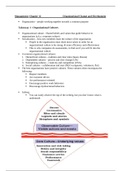1
Production, Location and Change (Case Studies)
Advanced Human Geography Options
Cambridge International AS and A Level Geography
For Syllabus 9696
Case Studies
➢ Extensive Sheep Farming in Australia (Pastoral System)
➢ Intensive Rice Production in Lower Ganges Valley (Arable System)
➢ Recent Changes in Jamaica’s Farming
➢ Jamaica’s Kew Park Farm
➢ The Changing location of EU Car Manufacturers to Slovakia
➢ The Management of Change in India’s Manufacturing Industry
➢ India’s New High-tech city: Bangalore
A Pastoral System - Sheep farming in Australia
Characteristics + Location
Sheep farming in Aus. 85 million hectares = major land use. Extensive farming. Main Physical
input = natural open ranges (fragile in nature). Sheep farms mainly located inland, semi-arid
areas. Human inputs low compared to other types + low labour + capital per H. Processes =
grazing, lambing, dipping, shearing. Outputs = lamb, wool, sheep skins.
Aus. = leading sheep producing country (120 million sheep). Largest wool producer/exporter,
largest exporter live sheep + lamb. Sheep + wool important for economy.
Sheep raised S. Aus. where moderate/high rainfall + drier New South Wales + Queensland.
Merinos (high quality wool = 75% countries sheep). 85 million hectares just for wool
production. Merino sheep survive harsh environments + produce heavy fleeces. 16% of sheep
breed for meat production. 9% used for both. 60,000 sheep farms (100-100,000 each).
Sheep + wool production occurs:
-High rainfall coastal zones
-Wheat/sheep intermediate zones
,2
-pastoral interior zone
¼ all sheep farmed in pastoral zone. Sheep farming in Aus. extensive in nature. Most extensive
in pastoral zone (semi/arid inland area). Here summer temp. high, rainfall low + drought. Lack
of grass, sheep eat saltbush. Pastoral zone, density sheep low, poor quality forage. Farming
input low (lowest in country). Farms large.
Coastal, intermediate zones land for arable farming, dairy + beef market gardening. Sheep kept
marginal areas (colder higher Wales). ⅔ Aus. sheep on farm that support 2,000 animals. Small
sheep farms on better quality land.
Farming Issues
-Weed infestation (hard control on large farms little capital) + destruction wildlife overgrazing
in marginal.
-Periodic droughts in dry areas.
-Soil loss due to wind + runoff.
-Animal welfare.
-shortage experience shearers. Shearers hard to find as mining industry higher wages. ¼ drop
2003-2006.
Arable System - Intensive rice production in lower Ganges Valley
Location
Intensive Subsistence rice cultivation in Lower Ganges Valley, India, Bangladesh. Ganges basin is
India's most extensive + productive agricultural area + densely populated. Delta region of
Ganges occupies large area Bangladesh. Rice = 75% diet in area. Physical conditions in lower
Ganges good for rice:
-21 degrees allows crops annually. Rice only 100 days growing season.
-Monsoon rainfall +2,000 millimetres sufficient to flood rice fields.
-Rich alluvial soils built up.
-Seasonal dry period for harvesting rice.
Large labour force
, 3
Cons of rice growing
- Flooding
- Droughts
- Shortage of land with growing population
- Lack of machinery
- Majority best land held by wealthy landlords
Water-intensive Staple Crop
Rice staple food of Asia. 90% Asian agricultural water used for rice. 5,000 litres used for 1 kg
rice. Intensive subsistence cultivation, crop grown small plots land, high labour. Called pre-
modern intensive farming as not like HIC market gardening = capital intensive. Wet rice grown
fertile silt flooded lowlands, dry rice on terraces. Drier rice easier but lower yields.
Farming System
Paddy Fields. Water provided by Ganges flooding or gravity canals. Wet rice during monsoon
season + dry during late Oct. Fish added to water for extra. Second rice crop in November.
Wells used in dry season. Water buffalo used for manure. Low incomes + capital subsistence
farming means hand labour is dominant. 2000 hours year to farm 1 hectare. High labour input
necessary to:
-Build embankments stabilised by coconut + banana trees.
-Irrigation canals where required for water supply.
-Plant nursery rice, plough paddy fields, transplant rice etc…
-Cultivate other crops during dry season, chickens + livestock.
During dry season cereal grown instead. Many farmers tenants, pay money to landlord. Seeds
stored for next crop.
Green Revolution
IR8 seed variety *3 food production, higher average yield + greater use fertilisers, tractors +
mechanised ploughs. Grants + loans to by new seeds.
Pros.






